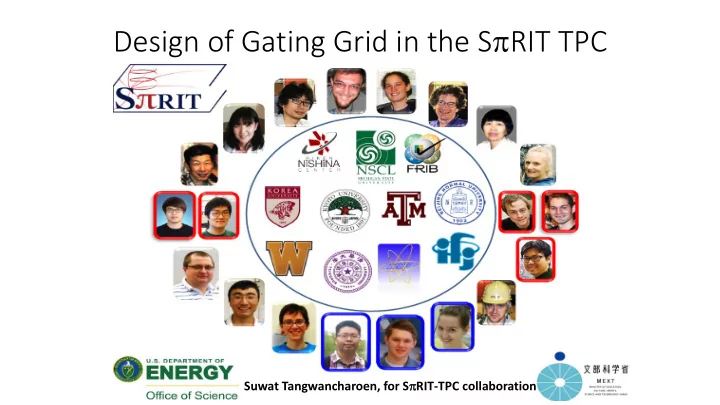

Design of Gating Grid in the S p RIT TPC Suwat Tangwancharoen, for S p RIT-TPC collaboration
SpiRIT TPC : Principle of operation • TPC is placed in a magnetic field which align with E-field in the TPC. • Beam particles ionize detector gas (P-10). • Ionized electrons drift in the opposite direction of the electric field towards charge Pad plane sensitive pads. • 3D paths from the position on the pads and arrival time. Path in ho horiz rizontal • Momentum from the curvature of the path. plane from • pad po pad posit itions Particle types from the energy loss and the curvature. Field cage 12 mm Pad Plane Anode Plane Avalanche Region Ground Plane x target Gating Grid Region Drift y RI beam E and B field direction Figure courtesy of J. Estee Figure courtesy of J. Barney
opens for real events in ~200ns. Gating grid driver r S p RIT Gatin ing grid rid for IT TP TPC: shorts positive and negative wires, I ave 18 A. Particle track Diam Pitch Height Tens. # of Plane Material Volt. (V) (µm) (mm) (mm) (N) wires Anode Au-W 20 4 4 0.5 ~1400 364 Electrons Ground Cu-Be 75 1 8 1.2 0 1456 Gating Cu-Be 75 1 14 1.2 -110±70 1456 Gating grid + - + - + - + - + - Operation of Gating Grid Ground Grid 6mm • Open : All wires have the same potential (-110 V). all electrons Anode can pass through to the multiplication region. 4mm • Close : Alternative wires are biased up or down by 70 V (-40 V Pads 4mm and -180 V). No electrons and ions pass the gating grid. Gating grid is opened
Function of gating grid electrons + - + - + + - - - • Prevent positive ions from drifting into the drift Gating Grid volume. ions 6 mm • Prevent amplification of unwanted events. Ground 4 mm • Reduce aging of wires. Anode 4 mm In typical experiment, the gating grid will stay closed most of the time until there is a candidate Pad Plane event. Closed configuration
Gating Grid reduces the Effect of free (space) charges • Majority of ions come from the avalanche near the anode wire. • Disturb the field in the drift volume. • Affect the drift velocity and the arrival time of electrons. • Accumulation of negative polymers will accelerate the detector aging. W. Blum, W. Riegler, and L. Rolandi Anode wire 25µm “Whisker” polymer deposits on anode wire. taken from J. Kadyk, NIM A300 (1991) 436
Garfield Simulation for gating grid: e Drift lines Positive ion drift lines Anode Pad Plane 12 mm Avalanche Anode Plane Region Ground Ground Plane Region Gating Grid Drift Gating grid
Electron drift lines Equipotential lines Pad plane Anode GND OPEN Gating grid Pad plane Anode CLOSE GND Gating grid
Design criteria of gating grid driver • Open the gating grid as fast as possible to reduce the “dead region.” • Discharge both alternative wires of the gating grid at the same rate to reduce the unwanted induced signal on the pads. -180 V -40 V Closed configuration from Garfield
Gating grid driver Unique design to short two power supplies Operation of the driver Gating grid open : +HV and – HV shorted through the mosfet switches. 4 Ω Transmission line 4 Ω Transmission line For S p RIT TPC, low impedance transmission lines • are used to transfer the charges from the gating grid. • Insure that the discharge from positive and negative sides is the same.
Prototype 1 Positive side of C • Use 2 BEHLKE switches (HTS 21-14). • Test with the standard capacitor (11.6 nF) TTL • The propagation delay of the switches are 120 ns ( too long). • There is a negative peak after discharging. 120 ns delay SPICE analysis of the prototype 1 • Inductance L = 160 nH • For C = 27 nF, circuit is critically damp. • The capacitance of the gating grid (including 2 transmission lines) is 26.5 nF.
GET preamp Test of Prototype 1 with TPC readout • The capacitance of the gating grid is measured to be 26.5 nF including 2 transmission lines. pad • Critically damp as expected. AGET Critically damp Positive side GG closed GG short GG open TTL Gating grid Negative side
Present Prototype • Use 2 pair of N-type and P-type mosfets that have the same turn-on delay time. • Green pair of mosfet switches is for closing the gating grid quickly.
Present Prototype (test with C =27 nF, R = 2 Ω , RC = 54ns) OPEN CLOSE TTL-1 TTL-1 2.5µs 200ns Discharge signal TTL-2 Discharge signal 50ns positive Turn on delay time 50 ns Close time 2.5 µs Open in 250 ns negative (inverted in the picture)
Trigger system Condition: Central collision • High multiplicities in the Scintillator trigger array and forward trigger array • Veto of Heavy residue (Z >20) Kyoto arrays : Trigger scintillators use MPPC readout
TTL-2 TTL-1 TTL-1 TTL-2
Backup slides
Electron transparency for gating grid Cathode potential -6 kV Gating grid Open : V gg Gating grid Close : V gg ± ∆ V offset Voffset increase with B-field
Electron transparency for gating grid Figure courtesy of J. Estee
SPICE (Simulation Program with Integrated Circuit Emphasis) Using RLC series circuit to analyze the signal shape. • The signal suggests that the system is slightly underdamp. • Need to be at least critically damp to get rid of the negative peak. • Assume that most inductance comes from the R = 4.8 Ω driver circuit. C = 11.6 nF L = 160 nH • Therefore, C needs to be 27 nF to achieve critically damp if R =4.8 Ω and L = 160 nH. • The capacitance of the gating grid of the SpiRIT TPC is measured to be 26.5 nF including 2 transmission lines.
GG with transmission lines
Recommend
More recommend